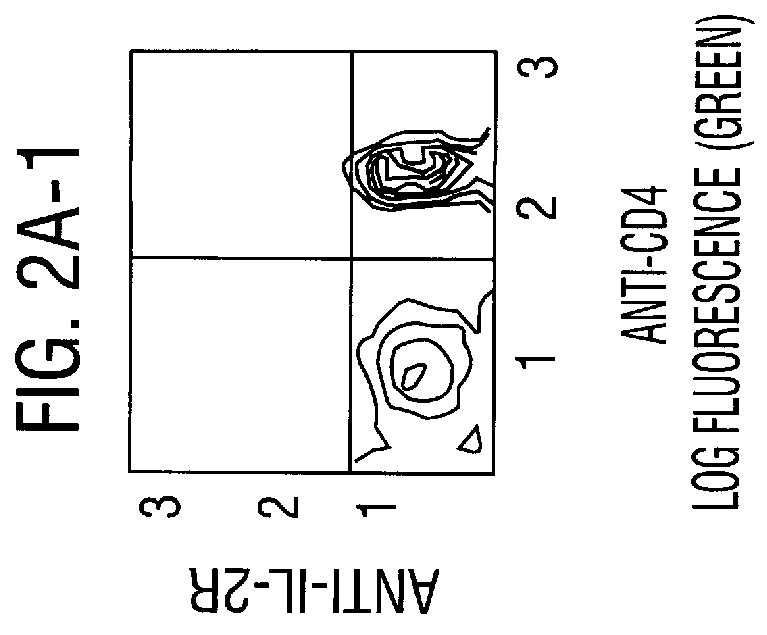Methods of promoting immunopotentiation and preparing antibodies with anti-CD3 antibodies
a technology of immunopotentiation and anti-cd3 antibodies, applied in the field of immunology, can solve the problems of imposing severe restrictions on triggering an immune response, too late for the immune system to save the organism, and too low doses of invading antigens to trigger an immune respons
- Summary
- Abstract
- Description
- Claims
- Application Information
AI Technical Summary
Problems solved by technology
Method used
Image
Examples
example 2
Activation of T-cells by Administration of Anti-CD3
To evaluate whether low doses of anti-CD3 were effective as activating T cells in mice, mice were given different doses and their lymph nodes and spleen cells were examined for IL-2R expression by flow-cytometry. IL-2R expression was enhanced at the three doses tested (4, 40 and 400 micrograms) and plateaued at 400 micrograms. (FIG. 2). When the same lymphoid cells were incubated in media containing human rIL2, their proliferation was enhanced in proportion to their IL-2R expression. The immune suppression which results from a dose of 400 microgram of anti-CD3 was the result of T cell depletion, T cell receptor blockade and modulation of the TcR complex. The net result was that the amount of cell surface CD3 available to react with antigen was decreased, rendering the T cell unable to respond to antigenic stimuli because efficient antigenic specific activation depends on the presence of intact TcR. Therefore the quantity of availabl...
example 3
Effect of Anti-CD3-Treatment on Sendai Virus Infection in Mice
The purpose of this example was to test the effect of mAb treatment on infection. Administration of low doses of anti-CD3 prevented the lethal pneumonia caused by the Sendai virus in >60% of mice. Anti-CD3 treated, virally-infected mice also developed lasting virus-specific immunity as evidenced by their ability to withstand a subsequent dose of Sendai virus of 1000 times the LD.sub.50 dose. Treated mice also developed a Sendai virus specific DTH and antibody response similar to mice immunized with a non-virulent Sendai virus vaccine. Interestingly, the 129 / J strain of mice were also protected by the anti-CD3 treatment. Because virus susceptibility in these mice has been shown to be caused by an inadequate generation of NK cell responses, it appears as if NK activity induced by the mAb treatment contributes to viral protection. (51)
example 4
Anti-CD3 Prevents Malignant Progressor Tumor Growth in Mice
The purpose of this example was to determine the feasibility of immunotherapy designed to prevent tumor outgrowth and induce tumor immunity by administering anti-CD3 in vivo to activate T cells. This possibility was tested in mice with the eventual objective of pursuing similar strategies in humans.
Effects of the anti-CD3 treatment on malignant tumor growth in vivo were tested in mice. The C3H fibrosarcoma 1591-Pro-4L a weakly immunogenic ultraviolet-light-induced murine tumor that lacks cell surface CD3 and FcR does not react directly with the anti CD3 used for treatment. This malignant tumor grows progressively in 95 percent of normal CD3H mice and eventually kills the mice by infiltrative growth without macroscopic evidence of metastases. None of the mice treated with 4 .mu.g of anti CD3 developed tumors in this experiment. (Table 7). Animals treated with 4 .mu.g of anti CD3 also developed tumor immunity because they fail...
PUM
| Property | Measurement | Unit |
|---|---|---|
| body weight | aaaaa | aaaaa |
| temperatures | aaaaa | aaaaa |
| pH | aaaaa | aaaaa |
Abstract
Description
Claims
Application Information
 Login to View More
Login to View More - R&D
- Intellectual Property
- Life Sciences
- Materials
- Tech Scout
- Unparalleled Data Quality
- Higher Quality Content
- 60% Fewer Hallucinations
Browse by: Latest US Patents, China's latest patents, Technical Efficacy Thesaurus, Application Domain, Technology Topic, Popular Technical Reports.
© 2025 PatSnap. All rights reserved.Legal|Privacy policy|Modern Slavery Act Transparency Statement|Sitemap|About US| Contact US: help@patsnap.com



